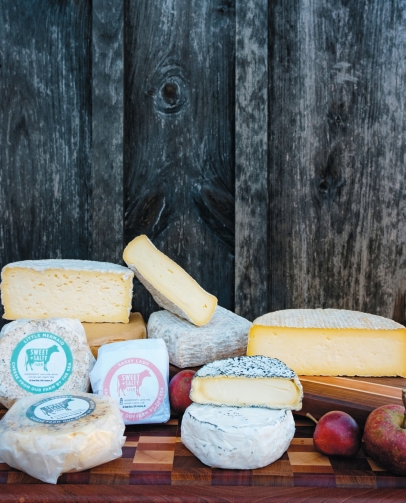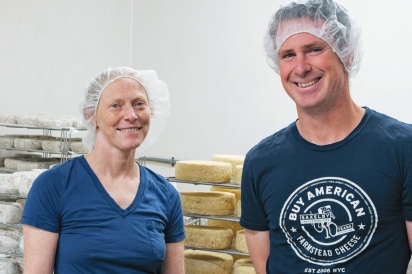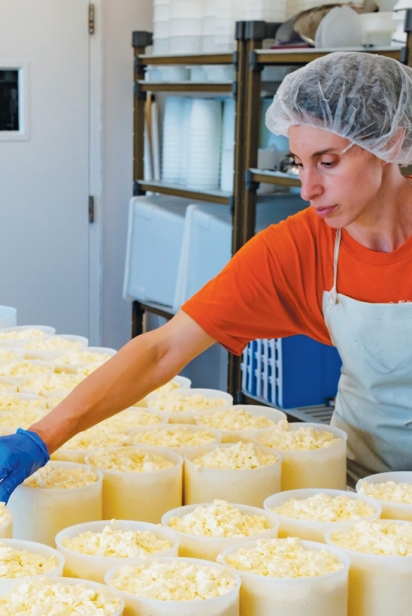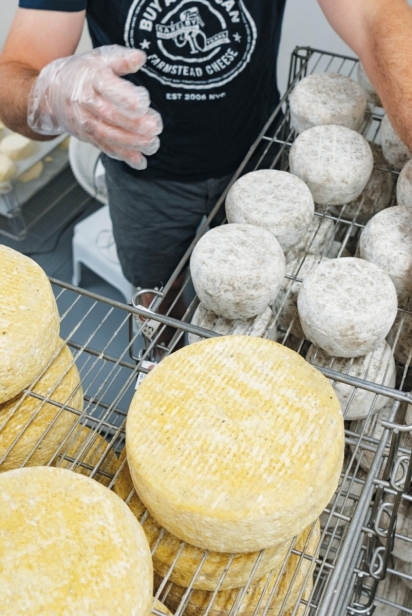Pasture to Palate at Sweet & Salty Farm
The sun is dipping down in the sky on a recent Monday afternoon at Sweet & Salty Farm, low-hanging clouds turning a fiery orange. Laura Haverland, who operates the small dairy off Shaw Road in Little Compton with her husband, Andrew Morley, reaches over an electric fence and rubs the nose of a chestnut-colored Jersey cow with wet, inquisitive eyes: Ginger.
“She’s super curious,” says Laura, as Ginger turns away and begins chomping up clumps of grass. “They’re not always so close to the buildings. You kind of lucked out.”
About a dozen other cows begin to meander over from the center of a tree-lined pasture. As we walk over to the farm’s main building and cheesemaking hub, Laura reminisces about leaving a 9-to-5 in Manhattan roughly a decade ago and taking a dive into the world of cheesemaking.
“I guess I never really wanted to sit behind a desk all day,” she says.
Owners of Sweet & Salty Farm, Laura Haverland and Andrew Morley.
Little Mermaid (light green sticker), Little Pepper (dark green sticker) Sassy Lady (pink sticker) and Little Doughnut with ash rind.
Humble beginnings
Sweet & Salty Farm has been in operation since 2013, but the couple first rented the farm property in 2011 and began construction of the creamery shortly thereafter. Nowadays, they milk a herd of roughly 20 Jersey cows daily, producing yogurt and cheese that’s sold straight to customers.
“We’ve always said that if we were larger scale, we would probably change our business model,” says Laura. Sweet & Salty sells almost exclusively at farmers markets with an online store for in-person pickups at the farm while their yogurt is available at some local grocery stores. Sweet & Salty is not certified organic but they follow all the same practices.
“We don’t use chemicals, pesticides, hormones, GMOs or antibiotics,” according to their website. “We believe in real food, produced with love and a very short ingredient list.”
The small creamery now produces roughly a dozen varieties of cheese, but the first year they were in business, things were as rocky as the ocean shoreline that borders the southern edge of the farm. After waiting three months for their first big production of cheese to age, the result was disappointing.
“We kept going back and tasting it and saying, ‘Why is there no flavor?’” Eventually they realized their aging room was all wrong and they would need to go back to the drawing board. They had to scrap the whole batch, selling only yogurt that first year in 2013.
“That was pretty depressing,” Laura says. I later ask her if she ever had doubts in those difficult early days or if she and her husband ever thought about quitting the cheese business.
“Me, personally, yes,” she says. “Andrew would say no, but he has a higher pain tolerance. We’ve come a long way since that first year.”
The cheese, please
We’re standing in the main production room as Laura begins to explain the process of turning fresh milk into cheese. It’s warm and humid; there’s a briny funk in the air. The Sweet & Salty team made a batch of their Time and Hope cheese that morning and Andrew is hosing leftover specks that didn’t make it into the molds from the stainless-steel worktable.
“We usually make the harder, aged cheese on Mondays,” says Laura. “On Tuesdays, we start a batch of our softer cheese and that’s about a three-day process.”
The fresh milk is pumped into a huge metal vat—essentially a double boiler—where it’s heated to a certain temperature before cultures are added and eventually a natural enzyme called rennet that helps coagulate the milk into curds. “It comes from a calf’s stomach,” says Laura. “We only use a traditional veal rennet.” As the mixture firms, it’s then sliced up with a long cheese curd knife into large or small chunks depending on the cheese and put into molds where it drains of whey.
“There are so many variables that go into it,” explains Andrew.
The real magic, it seems, happens during the aging process. Every cheese is dry salted or dunked in brine to introduce salt, then different varieties are brushed several times a week with beer, wine or spirits; some get wrapped in things like grape leaves or rubbed with vegetable ash. The length of aging is also a huge factor in how a cheese will turn out.
“We are lucky to have talented and hardworking people working with us at the farm,” says Andrew. “It allows us to put collective energy into new and fun ideas—and, soon, to move forward on some collaborations with other Rhode Island farmers and food artisans.”
“Cheesemakers Glenn Sherman and Heather LaDuke develop a lot of the cheeses,” says Laura. “And sometimes they’re just kind of an accident.”
One of their varieties, Little Mermaid, started as a whim.
“When we first started, Andrew read every book he could get his hands on about animal health. He was reading about how kelp and seaweed is so good for animal health as a superfood. He was, like, ‘We should be putting kelp on everything we eat. Why don’t we wrap a cheese with it?’”
To their surprise, it worked—adding an interesting taste of the ocean they found fitting for a Rhode Island creamery located on the water.
As we head into the aging room, I’m told it’s not underground because the water table in Little Compton is so high, but it’s built into a hillside to help regulate the temperature.
We’re surrounded by dozens of wheels of cheese. Their mainstay, Peach Fizz—a firm and dense cheese washed three times a week with Farmer’s Fizz sparkling wine from nearby Westport Rivers Vineyard—is in the center of the dank, cement-walled room.
On one side are soft cheeses like Little Something, a soft and gooey cheese in the style of brie or Camembert. In the other corner of the room, the morning’s bounty of Time and Hope is still in molds. A square semi-soft cheese called Main Squeeze rests on racks against another wall. “That’s probably my favorite right now,” Laura says. “It melts really well, in addition to being quite … squeezable.” As we walk back through the production room, the small herd of Jersey cows is still visible in the distance, framed perfectly in the window as the sun begins to set.
For more information including where to purchase cheese, visit SweetAndSaltyFarm.com.
All photos for this story were taken by Ezra Pollard, a Rhode Island based photographer with a focus in food, beverage and hospitality.








